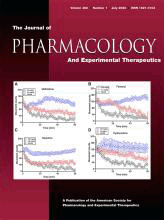 | |
| Discipline | Pharmacology, therapeutics |
|---|---|
| Language | English |
| Edited by | Beverley Greenwood-Van Meerveld |
| Publication details | |
| History | 1909–present |
| Publisher | Elsevier, on behalf of the American Society for Pharmacology and Experimental Therapeutics |
| Frequency | Monthly |
| Delayed, after 12 months; Hybrid | |
| 3.1 (2023) | |
| Standard abbreviations | |
| ISO 4 | J. Pharmacol. Exp. Ther. |
| Indexing | |
| CODEN | JPETAB |
| ISSN | 0022-3565 (print) 1521-0103 (web) |
| LCCN | sf80000806 |
| OCLC no. | 1606914 |
| Links | |
The Journal of Pharmacology and Experimental Therapeutics is a monthly peer-reviewed scientific journal covering pharmacology. It was established in 1909 and is published by Elsevier on behalf of the American Society for Pharmacology and Experimental Therapeutics. The journal publishes mainly original research articles, and accepts papers covering all aspects of the interactions of chemicals with biological systems.
Contents
John Jacob Abel founded the society in December 1908 when he invited 18 pharmacologists to his laboratory in order to organize a new society. [1] At the end of the meeting Abel announced the establishment of the journal. [2]